This four-image mosaic comprises images taken from a distance of 28.4 km from the centre of Comet 67P/Churyumov-Gerasimenko on 16 January. The image resolution is 2.4 m/pixel and the individual 1024 x 1024 frames measure 2.5 km across. The mosaic is slightly cropped and rotated, and measures 4.5 x 4.2 km.
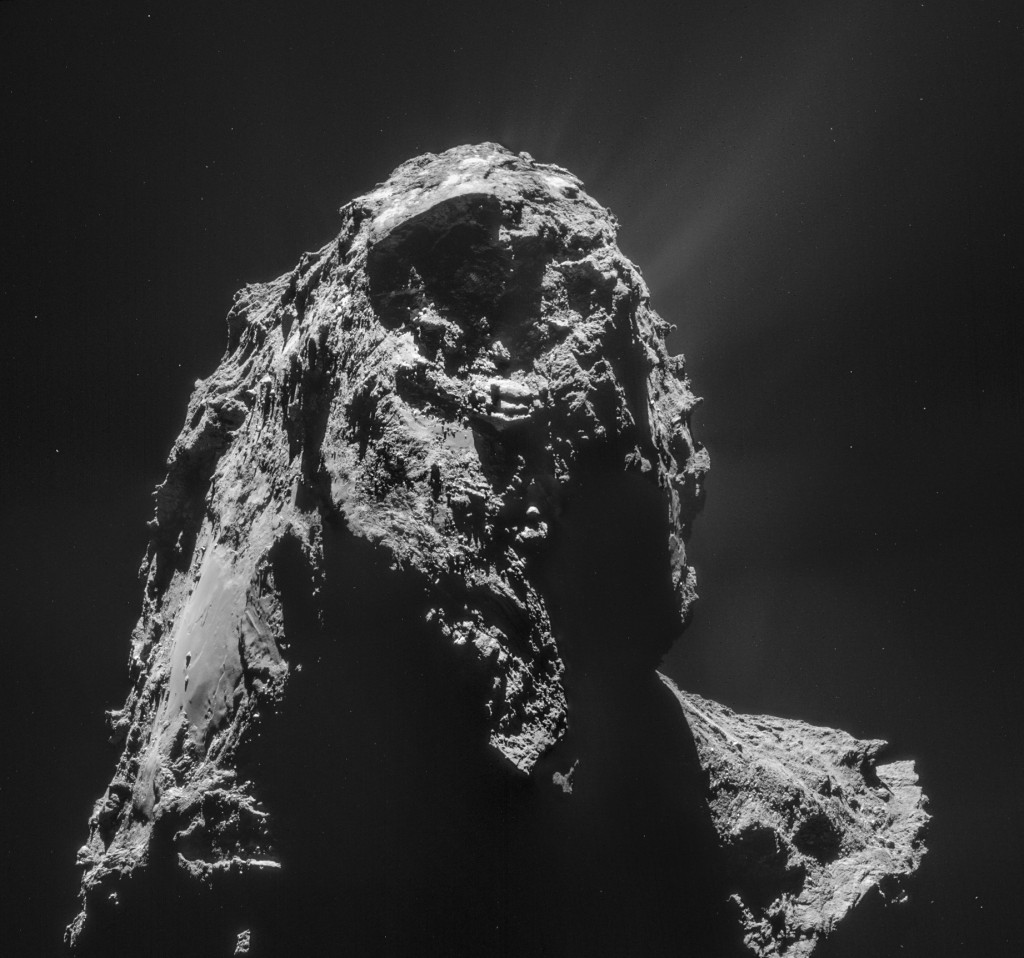
Four image mosaic comprising images taken on 16 January 2015 by Rosetta’s Navigation Camera (NAVCAM). Rotation and translation of the comet during the imaging sequence make it difficult to create an accurate mosaic, and there may be some spurious spatial and intensity features as a result of the mosaic-making sequence, so always refer to the individual frames before performing any detailed comparison or drawing conclusions about any strange structures or low intensity extended emission. Credits: ESA/Rosetta/NAVCAM – CC BY-SA IGO 3.0
The image portrays 67P/C-G from an unusual angle, providing a side view onto the Imhotep region, home to Cheops and its neighbouring boulders on the underside of the comet’s larger lobe (left hand side of the image). At the same time, the rough terrains and cliffs on the transition region between the comet’s neck and its smaller lobe can also be seen, steeply declining towards the well-defined edge in the lower right corner of the image.
While the curious orientation of the comet in this image is similar to that of the 2 November CometWatch, a slightly different illumination reveals a wealth of surface details on one of the sides of the larger lobe (in the foreground in this image) that were previously hidden.
Among the interesting features that now stand out are what appears to be a series of almost parallel structures visible just above the image centre and, below them, a secluded pocket of smooth terrain punctuated with a few boulders. Also in contrast to the 2 November view, we can now see the crisp outline of the comet’s larger lobe and signs of cometary activity towards the top left of the image.
The four individual 1024 x 1024 frames, along with a montage of the frames, are provided below:

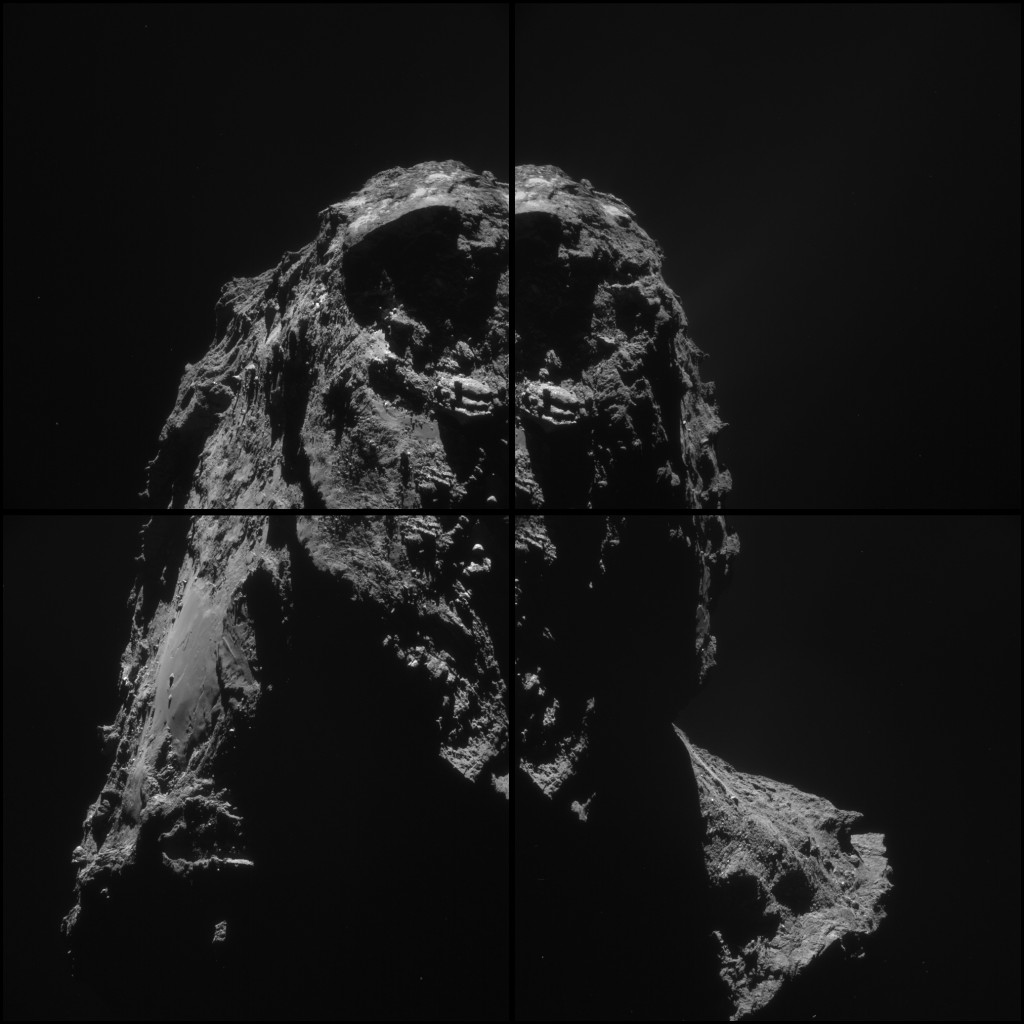
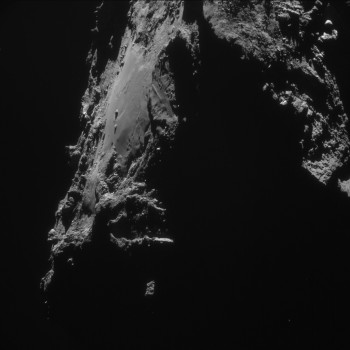
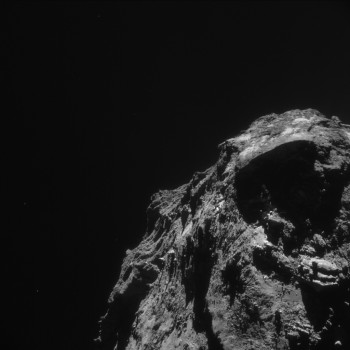
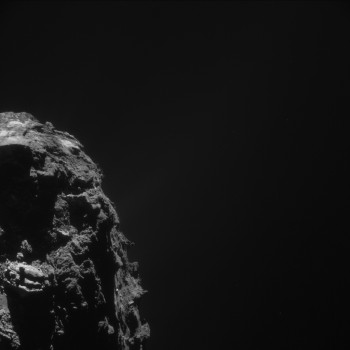
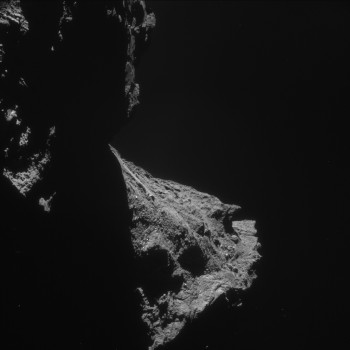








Discussion: 23 comments
Amazing image displaying the detailed structures of an arc discharge. A rotating filament of plasma is what formed exactly what Claudia pointed out here, “Among the interesting features that now stand out are what appears to be a series of almost parallel structures visible just above the image centre.”
Furthermore, as the filament travels across the surface, it does not do so smoothly. It sputters across. So we’d expect exactly what we find, “crater chains” with sometimes overlapping edges.
The evidence is unbearable: sharply cut edges, uniform depth of crater chains, flat typically smooth floors, and rotationally eroded walls. Take another look at Olympus Mons on Mars and you’ll see everything I just listed, including radial feathering streamers farther out (Lichtenberg figures).
Back to Comet 67/P, there are two patterns I will layout for you. The first is the chain of three craters in the center of the image. The bottom one was formed first, then the middle, and the finally the largest towards the top of the image. The discharge probably remained in the same location with the comet nucleus rotating beneath it. The second pattern is Imhotep itself. We can see that this region is actually the central smooth-floored area of a large circular depression. Right on its edge we see the all too familiar circular excavation, formed when the large rotating filament is weakened and secondary smaller filaments form on the outer boundary. Again, this is a direct analogy to Olympus Mons and hundreds of structures throughout the Solar System, irresponsibly assumed only to be impact caused without further investigation.
The parallel structure were also visible from another angle in https://blogs.esa.int/rosetta/2014/11/26/cometwatch-20-november-in-the-shadow-of-the-coma/ and https://blogs.esa.int/rosetta/2014/09/19/cometwatch-19-september/.
The ‘old lady’ perspective of 67P. We are getting more lighting 🙂
What a dramatic and great view on P67 !!!!
Birgit
Hello Claudia, I realise it is not directly relevant to this image but may I post three questions to you here.
Is there a schedule for the future scientific measurements programme and would it be possible to publish at least a synopsis of it. This would give us an idea of what to expect and when rather than not knowing at all what is going on in the present before being hit with the odd event.
Also is there any flexibility in the schedule so that additional measurements can be made depending on discoveries.
And finally is there any order of priorities in the schedule.
Thanks Claudia,
a great picture, just when we though we knew the comet, we get this detailed look, that throws up some new structures.
How ever the sky around the comet is full of debris for the want of a better word.
I have not seen the comet so active before, with so many of the larger bits of debris moving around.
Personally, I’m intrigued by that huge, roughly circular, crater-like feature at the top of the image: firstly because I don’t remember seeing it as such in any previously released image, presumably because it is only now starting to emerge from the shadow of the night-side of the nucleus; and secondly because nobody has yet commented on it despite the fact that it leaps off the screen at us… It is true we were much more used to seeing the similar, much better-known feature at the other end of the comet, on top of the ‘head’ lobe, which Philae bounced over.
Whatever, this new feature is one more, spectacular specimen on the comet surface of large-scale, roughly circular or hexagonal features which nobody, as far as I know, has ever called “impact craters”.
Hi THOMAS. Even the word ‘crater’ is used very carefully now.
Indeed, Logan! The crater-like features observed on 67P are so clearly not due to impacts that it is presumably judged wiser by mission researchers and most others on this blog to avoid the term “crater” altogether. As far as I know, nobody has yet come up with a more politically correct term. Any suggestions anyone? I propose “crater-like feature” (CLF), quite simply. Meanwhile, all discussion of the real origin of these CLFs is prudently avoided.
But this also brings up the question of whether the CLFs observed on other comet nuclei (not to mention those observed on the rocky planets and planetary moons throughout the Solar System) are themselves actually *impact* craters or something utterly different.
Decidedly, the observations from 67P are calling absolutely everything into question…. And this is just the beginning!
Great view! A high-resolution image of this region would be fantastic. Yes, Osiris-team, I’m talking with you! 😉
In the center of the dark cliff towards the top is this a pixel glitch or something else?
https://tinypic.com/r/10h3ou1/8
Not the right size 😉
Beautiful image, seems we are beginning to see the coma?
Something completely different: is the Matt Taylor who posts in the blog the same as the BBC weather man Matt Taylor?
Another question. Have been thinking more about sublimation. With H2O in the coma, the theory is that it is being sublimated from under the dust and I guess from under the hard crust. Would the sublimated H2O AFFECT the dust in any way besides propelling it? On earth I’d assume that sublimation would tend to moisten it, but I very much doubt that’s the case here for many reasons. But, regarding the jets, the dust is supposed to come from being more or less evenly mixed with the volatiles, so would there be evidence of these volatiles (molecules perhaps) on the dust?
‘Non-bounded’ grains should be very ‘aromatic’, Sovereign Slave 🙂
Is something ‘chopping’ Cheops? 😉
[Seems smoother].
Find this photo extremely beautiful. Emily is right. Ducky macro texture looks like a very spongy ‘rock’ made of ‘snowy’ dust. ‘Snowy’ in a 3D connotation (with all their geometric consequences). Surface seems infinite, in a fractal way. [Sorry about my insistence in the use of this word].
Mental modeling: We have a planar circle of 100m, with a regularly porous surface, with the same porous structure down to 100m, releasing gas to empty space.
Now lets draw circles at 10m, 20m, …90m.
Are the gas molecules being emitted at the central circle as chaotic (in direction) as those of the perimeter circle? Doesn’t some ‘collimation’ occur? The outer circles progressively creating a ‘gas made’ nozzle towards the inside circles? 😉
If this process occur over extensive planar surfaces, then this phenomena, doesn’t create ‘cells’, regular in size and disposition [aka regular ‘craters’]?
So, comets should be ‘lung-y’ astronomical objects 🙂
From a very, very ‘un-healthy’ place :/
“…what appears to be a series of almost parallel structures visible just above the image centre and, below them, a secluded pocket of smooth terrain punctuated with a few boulders.”
Seems to me pressure made pockets refilled at some time in 67P’s life with what should be mainly H20 by now.
Those structures are part of what -using Thomas lexicon- amount to a probable explosive CLF ‘crater-like-feature’.
My take on this mosaic:
https://www.flickr.com/photos/105035663@N07/16247206598/in/photostream/
Levels adjusted:
https://www.flickr.com/photos/105035663@N07/16433954322/in/photostream/
I also made a movie with pictures taken on 2 November and 16 January:
https://www.youtube.com/watch?v=s3qflVyfCsk